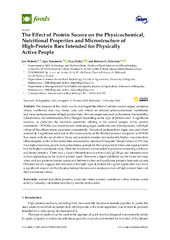Приказ основних података о документу
The Effect of Protein Source on the Physicochemical, Nutritional Properties and Microstructure of High-Protein Bars Intended for Physically Active People
| dc.creator | Malecki, Jan | |
| dc.creator | Tomašević, Igor | |
| dc.creator | Đekić, Ilija | |
| dc.creator | Solowiej, Bartosz | |
| dc.date.accessioned | 2020-12-17T22:52:04Z | |
| dc.date.available | 2020-12-17T22:52:04Z | |
| dc.date.issued | 2020 | |
| dc.identifier.issn | 2304-8158 | |
| dc.identifier.uri | http://aspace.agrif.bg.ac.rs/handle/123456789/5298 | |
| dc.description.abstract | The purpose of this study was to investigate the effect of protein sources (algae, pumpkin, wheat, sunflower, rice, soy, hemp, pea, and whey) on selected physicochemical, nutritional, and structural parameters of high-protein bars. Texture properties, such as hardness, fracturability, cohesiveness, and adhesiveness, have changed depending on the type of protein used. A significant increase, in particular the hardness parameter relating to the control sample (whey protein concentrate-WPC80), was noted for bars containing algae, sunflower, and wheat proteins, with high values of the adhesiveness parameter concurrently. The use of proteins from algae, pea, and wheat resulted in a significant reduction in the water activity of the finished product compared to WPC80. Bars made with the use of wheat, hemp and pumpkin proteins had noticeably higher viscosities than other samples. Color of the tested bars measured by means of Computer Vision System (CVS) was from light cream (soy, pea) to dark green (hemp, pumpkin). Bars prepared of wheat and algae proteins had the highest nutritional value, while the lowest one was recorded in products containing sunflower and hemp proteins. There was a clear differentiation of amino acids (g/100 g) and microstructure in bars depending on the type of protein used. However, a slight similarity can be found between whey and soy proteins (amino acids) and between whey and sunflower proteins (microstructure). Obtained results suggest that selection of the right type of protein for a given application may have a significant impact on the physicochemical features and microstructure of high-protein bars and their nutritional values. | en |
| dc.publisher | MDPI, BASEL | |
| dc.relation | Ministry of Science and Higher Education in PolandMinistry of Science and Higher Education, Poland [0029/DW/2018] | |
| dc.rights | openAccess | |
| dc.rights.uri | https://creativecommons.org/licenses/by/4.0/ | |
| dc.source | Foods | |
| dc.subject | animal and plant proteins | en |
| dc.subject | computer vision system | en |
| dc.subject | nutritional value | en |
| dc.subject | texture | en |
| dc.subject | water activity | en |
| dc.subject | viscosity | en |
| dc.subject | microstructure | en |
| dc.subject | heavy metals | en |
| dc.subject | amino acids | en |
| dc.title | The Effect of Protein Source on the Physicochemical, Nutritional Properties and Microstructure of High-Protein Bars Intended for Physically Active People | en |
| dc.type | article | |
| dc.rights.license | BY | |
| dc.citation.issue | 10 | |
| dc.citation.other | 9(10): - | |
| dc.citation.rank | M21 | |
| dc.citation.volume | 9 | |
| dc.identifier.doi | 10.3390/foods9101467 | |
| dc.identifier.fulltext | http://aspace.agrif.bg.ac.rs/bitstream/id/3799/5295.pdf | |
| dc.identifier.scopus | 2-s2.0-85092628613 | |
| dc.identifier.pmid | 33076297 | |
| dc.identifier.wos | 000586136000001 | |
| dc.type.version | publishedVersion |


